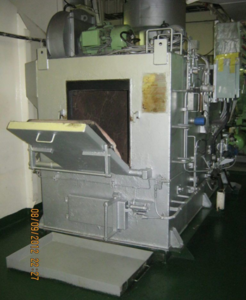An incinerator is a piece of equipment on board that helps ships save money on waste disposal. It is used to burn solid and liquid waste generated on ships during normal operations, as well as to reduce overall waste from ships.
Atlas Incinerators , which are important MARPOL equipment, require proper knowledge and guidelines for maintenance and operation.
Incorrect operation or under-maintenance of an incinerator can reduce overall efficiency and lead to serious accidents.

The following are eight common problems that occur in ship’s Atlas Incinerators, and how to deal with them.
- Flame Failure Alarm
One of the first things to do after receiving a flame failure alarm is to inspect the flame sensor. Flame sensors frequently become clogged, resulting in flame failure alarms.
Remove and clean the sensor in such cases before reinstalling it. This would solve the problem (If the sensor is defective, put a new one).
Among the other causes of a flame failure alarm are:
- Ignition failure
- Dirty Burner
- Defective flame sensor
- Blocked diesel oil nozzle
- Defective solenoid valve
- Clogged fuel line filter
- Incorrect opening of air damper
Engineers will have to clean the burner’s flame scrod and blast tube if it is dirty. If that doesn’t work, inspect the spark electrodes, which could be the cause of the ignition failure. Cleaning and adjusting spark electrodes can solve the problem of ignition failure.
Replace any clogged diesel oil nozzles with clean ones. A faulty solenoid valve can also cause a flame failure alarm. If the same problem is discovered, replace the solenoid valve/coil.
Finally, improperly opened air dampers may prevent the proper amount of air from reaching the combustion chamber, resulting in ignition failure. To resolve the problem, check the opening and closing of the air damper.
- High Flue Gas Temperature Alarm
The most common cause of high flue gas temperature alarms is faulty or defective temperature sensors.
Other causes for concern include:
- Faulty inverter and transmitter
- Blocked air cooling inlet
- Leaking dosing pump stator
- Leaking or defective solenoid valve
- Clogged cooling panel slot
- Defective pressure control
- Throttling brick fallen out
Faulty inverter and transmitter circuits, as well as inputs, should be checked and adjusted as needed. Regularly check the pressure control and solenoid valves.
- High Combustion Chamber Temperature Alarm
The following are the primary causes of a high combustion chamber temperature alarm:
- Alarm sensor problem
- The volume of solid waste inside the incinerator is greater.
- Refractory failure
If the outlet is clogged with slag or the slot at the combustion chamber floor level is clogged, a high combustion chamber temperature alarm will sound.
- Sludge Oil Leaking
Sludge oil leaks primarily from the combustion chamber’s base plate corners. Some of the most common causes of sludge oil leakage are:
- Incorrectly opened oil burner air damper
- Under-pressure is extremely low.
- Atomizing valve is closed.
- faulty valves in a programmable logic controller (PLC)
- Sludge nozzle atomizing slot is clogged.
Check that the atomizing slot is open 3/4th to 1 full turn and that the PLC valves are set according to the manual. In the event that the under-pressure is too low, check the under-pressure control function.
Check the air damper’s opening and closing functions if it’s not working properly. If the sludge nozzle atomizing slot is clogged, open it and clean it.
- Cracks in Refractory of Combustion Chamber
The main cause of cracks in combustion chamber refractory is a rapid change in temperature caused by filling the sludge tank with water during high-temperature sludge operation. It should be noted that the sludge tank should never be filled while the sludge is burning.
Machine vibrations are also a major source of this issue. In order to avoid this, adequate deck support should be reinforced.
This issue can also be caused by leaking door gaskets. Gaskets should be adjusted and replaced as needed.
- Draft failure / Low Pressure Alarm
A faulty pressure sensor is one of the first things to look for when troubleshooting draft failure or extremely low under pressure alarms. Other causes of the issue include:
- Door gasket damage
- Fan belt failure
- Fan rotation in the wrong direction
- Failure to open the flue gas damper
- Sensor tube leakage
Check the fan belt and door gasket at regular intervals. Faulty fans, flue gas dampers, and sensor tubes must all be inspected and repaired as necessary.
- Leaking Mechanical Seal Sludge Pump
It should be noted that the sludge pump should not be run dry for an extended period of time to avoid mechanical seal leakage. Replace the seal as needed. Furthermore, large amounts of debris in the sludge can harm the mechanical seal. In such cases, flush and clean the lines before restarting the system.
These are some of the most common problems with the ship’s incinerator. Regular maintenance and inspections are critical to ensuring the smooth and safe operation of this critical ship machinery system.


